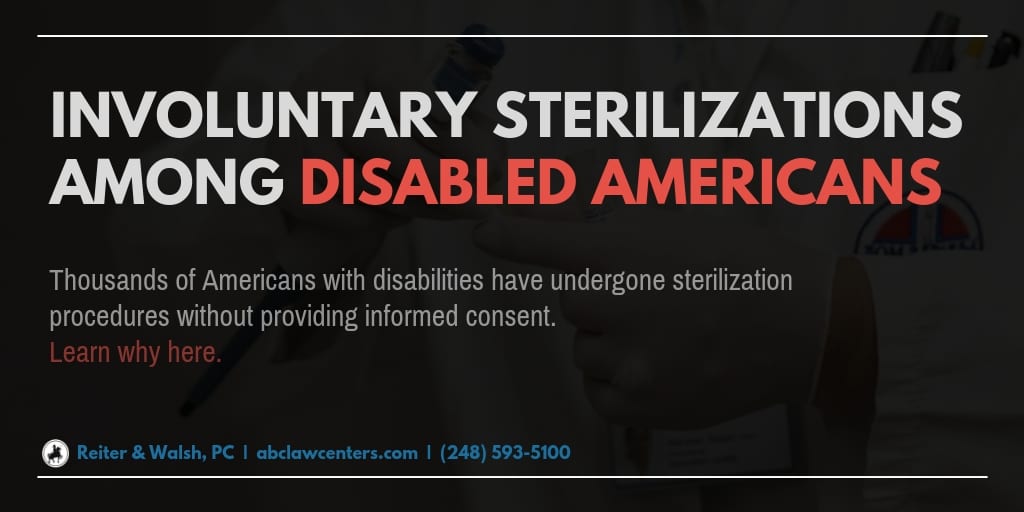Thousands of Americans with disabilities have undergone sterilization procedures without providing informed consent. Beginning in the early 1900s, supporters of the eugenics movement sought to sterilize those with cognitive impairments in order to “cleanse” the human gene pool of “undesirable” traits. This was sanctioned by many state governments, as well as the U.S. Supreme Court (Buck v. Bell). To the surprise of many, this Supreme Court ruling has never been formally overturned. Moreover, non-consensual sterilization of people with intellectual disabilities is still legal in many parts of the U.S., although the motivations behind it have shifted.
Why is non-consensual sterilization still legal, and under what circumstances is it allowed?
The non-consensual sterilizations that are performed today are typically done so at the request of a disabled person’s parents or guardians, who believe that sterilization (hysterectomies, vasectomies, etc.) will improve their child/ward’s quality of life and/or make them easier to care for.
Here, we will discuss the laws and ethics surrounding the sterilization of disabled people. First, we’ll provide some historical context on the eugenics movement, and then explore current controversies regarding consent and decision-making power.
The rise of eugenics and compulsory sterilization in the U.S.
In the early 1900s, eugenicists began to treat people with disabilities as sub-human. According to Merriam-Webster, eugenics is “the practice or advocacy of controlling selective breeding of human populations (as by sterilization) to improve the population’s genetic composition.” Perhaps the most well-known example of eugenics is the Holocaust, but the eugenics movement also led to many smaller-scale atrocities.
In the early 20th century, U.S. eugenicists perceived two threats to the American gene pool: the entry of new “undesirables” and the reproduction of “undesirables” who already lived here. The first they addressed by promoting draconian immigration reforms. The second, by passing laws against racial mixing, and sterilizing those whom they did not want to reproduce (1, 2).
Although many different groups of Americans have been forcibly sterilized (click here for more information about other minority groups targeted), this article will focus on those with disabilities.
The first state law allowing sterilization of people with disabilities was passed in Indiana in 1907, to prevent “…the procreation of confirmed criminals, idiots, imbeciles, and rapists.” (3). Other states soon passed similar legislation, often referring to candidates for sterilization as “feebleminded” – an astoundingly broad term that encompassed everything from an inability to “appreciate moral ideals” to impairments of hearing or vision (2). Many of the people who were forcibly sterilized were residents of mental institutions, and they often weren’t even told what was being done to them. In many cases, they were led to believe they were having an appendectomy (1). The government of California was particularly extreme, eventually sterilizing approximately 20,000 people (2).
Adolf Hitler may have even gotten some of his abhorrent ideas from American sterilization programs. In Mein Kampf, which he published in 1925, he wrote that,
“There is today one state in which at least weak beginnings toward a better conception [of citizenship] are noticeable. Of course, it is not our model German Republic, but the United States.” Shortly after he took power (in 1933), Hitler announced sterilization laws in Germany (4) – an ominous beginning to the largest genocide in history.
Buck v. Bell: U.S. Supreme Court legalizes eugenic sterilization
In 1927, the U.S. Supreme Court upheld a Virginia statute allowing for forcible sterilization of people considered “unfit” to reproduce; this statute had been enacted to protect doctors conducting such procedures from medical malpractice lawsuits.
The case, Buck v. Bell, was focused on a woman named Carrie Buck, who the state of Virginia wished to sterilize, claiming she was promiscuous and “feebleminded,” and that these traits were genetic and would be passed to her offspring.
In reality, Carrie had become pregnant after a relative of her foster family raped her (5), and the family sent her to an asylum to cover up the truth (2). Scholars believe that Carrie had no major physical or mental impairments (1). Of course, by today’s moral standards, eugenic sterilization is completely unacceptable regardless of sexual habits or disability, but these inaccurate assessments highlight the lack of thought that went into sterilization decisions.
Carrie’s mother, Emma, was also deemed “feebleminded,” as was her daughter, Vivian, after a cursory examination in infancy. (Vivian went on to be an honor student [5]). Their “diagnoses” were used as evidence that this trait was genetic and that sterilization was warranted.
The Supreme Court rejected Carrie’s arguments that involuntary sterilization violated the Eighth Amendment (which protects against “cruel and unusual punishment”) and the Fourteenth Amendment (which mandates that states provide “any person within its jurisdiction the equal protection of the law”). There was only one dissent (Justice Butler).
In explaining the decision, Chief Justice Oliver Wendell Holmes notoriously wrote that, “Three generations of imbeciles are enough” (3). Justice Holmes was so committed to the eugenics movement that, in a letter to a friend, he wrote that he wasn’t opposed to infanticide “to reduce the number of ‘undesirables’” (6).
Lasting impact of Buck v. Bell
Buck v. Bell provided legal precedent for many other states to enact compulsory sterilization laws. From the 1920s through the mid 1970s, over 60,000 people in the U.S. were involuntarily sterilized (3). Sterilization procedures not only had lasting physical and psychological effects on the victims, but also sometimes resulted in death (2).
Buck v. Bell has actually never been overturned by the Supreme Court, although state statutes allowing for eugenic sterilization have been repealed. Additionally, a subsequent Supreme Court decision regarding involuntary sterilization of criminals (Skinner v. Oklahoma) undermined much of the rationale used (3).
Nevertheless, it stands out as one of the worst Supreme Court decisions in history. As Adam Cohen, author of Imbeciles (a book about the case), told NPR,
“…there was something just so ugly about this decision and when [we] think about what we want the Supreme Court to be, what the founders wanted the Supreme Court to be, it was supposed to be our temple of justice, the place that people could go when all the other parts of our society, all the other parts of the government, were not treating them right.”
Cohen also warns that, “The idea that those who don’t remember the past are condemned to repeat it – it’s very troubling that we don’t remember this past” (1).
Current controversies: decision-making power and sterilization of people with disabilities
In recent years, discussion of involuntary sterilization has centered less on eugenics and more on guardianship and surrogate decision-making power. (Although it would be far from accurate to say that the eugenics movement no longer influences sterilizations: click here to read about a recent scandal involving the California prison system.)
Pro-sterilization arguments
Today, many sterilization cases concerning people with disabilities involve petitions from parents (or guardians) asking for the procedure. Initially, such requests were often granted; Disability Justice notes that,
“Early cases tended to support the rights of parents and other guardians to approve the sterilizations of people who were considered incapable of making their own decisions, sometimes using the Fourteenth Amendment to justify its ruling, arguing that since institutionalized adults were being sterilized with the approval of substitute decision makers, denying the same ‘right’ to people living in the community violated the right to equal protection” (3).
Parents who seek these procedures often do so for the following reasons:
- Fear that their child will be sexually assaulted and become pregnant.
- Concern that their child will engage in sexual activity without understanding that pregnancy is a possible outcome, and be unable to care for a baby.
- Desire to eliminate menstrual periods (some women with intellectual disabilities find it difficult or impossible to use feminine hygiene products).
Anti-sterilization arguments
More recently, disability advocates have argued that in many cases, these sterilizations are unconstitutional. Certain cases have been particularly controversial, such as the 2006 “Ashley Treatment,” in which a six-year-old was given a hysterectomy in addition to other procedures to stunt her growth so that her parents would be able to more easily care for her throughout her life.
Advocates often object that sterilizing a person who is cognitively impaired and unable to provide consent violates the “fundamental right to keep one’s person inviolate from unwanted intrusions” and the right to bear children, among other important laws (7).
Many people have also pointed out that while sterilization can prevent unwanted pregnancy, it does not prevent sexual abuse of people with intellectual disabilities, which occurs at shocking rates. Or, as Ari Ne’eman put it in a statement for the American Civil Liberties Union (ACLU), sterilization “can merely hide evidence of [sexual assault]” (8). Ne’eman instead emphasizes the importance of taking steps to ensure that people with intellectual disabilities are protected from sexual abuse (click here to learn more about this topic).
Regarding the issue of menstruation and hygiene, some advocacy organizations consider this to be a matter of convenience to the parents rather than something that is actually in the best interests of the child. The American College of Obstetricians and Gynecologists (ACOG) has urged physicians to consider that in some cases, parents and patients may have conflicting interests (9).
When is sterilization appropriate? Guidelines from Human Rights Watch
The non-profit organization Human Rights Watch has issued recommendations (10) that they hope to see reflected in policy, professional guidelines, and ethical standards. These recommendations include the following:
- Women must give informed consent before having a sterilization procedure, and understand that it cannot be reversed. (They note that, “Perceived mental incapacity, including medically or judicially determined mental incapacity, does not invalidate the requirement of free and informed consent of the woman herself as the sole justification for the sterilization.”)
- Although doctors may perform certain actions without informed consent in the event of a medical emergency, prevention of future pregnancy does not constitute such an emergency.
- Children should not be sterilized.
- Women and girls with disabilities should be included in the evaluation and development of laws on sterilization and related matters.
For more detailed information on their recommendations, click here.
Want to learn more?
For additional information on sterilization laws that have affected people with disabilities, click here for an extensive historical database that breaks laws down state-by-state.
Sources
- The Supreme Court Ruling That Led To 70,000 Forced Sterilizations. (2016, March 07). Retrieved October, 2018, from https://www.npr.org/sections/health-shots/2016/03/07/469478098/the-supreme-court-ruling-that-led-to-70-000-forced-sterilizations
- Nourse, V. (2011). Buck v. Bell: A Constitutional Tragedy from a Lost World. Pepp. L. Rev., 39, 101.
- The Right to Self-Determination: Freedom from Involuntary Sterilization. (n.d.). Retrieved October, 2018, from https://disabilityjustice.org/right-to-self-determination-freedom-from-involuntary-sterilization/
- It’s time for California to compensate its forced-sterilization victims. (2015, March 05). Retrieved October, 2018, from http://www.latimes.com/opinion/op-ed/la-oe-0306-bold-forced-sterilization-compensation-20150306-story.html
- Lombardo, P. A. (2003). Facing carrie buck. Hastings Center Report, 33(2), 14-17.
- Eugenics Alive and Well in America: Sterilization Case Buck v. Bell Still Matters. (2017, November 17). Retrieved October, 2018, from https://www.cnsnews.com/commentary/eric-metaxas/eugenics-alive-and-well-america-sterilization-case-buck-v-bell-still-matters
- Unwanted Sterilization and Eugenics Programs in the United States. (n.d.). Retrieved October, 2018, from http://www.pbs.org/independentlens/blog/unwanted-sterilization-and-eugenics-programs-in-the-united-states/
- Ne’eman, A. (2018, February 01). Washington State May Make It Easier to Sterilize People With Disabilities. Retrieved November 6, 2018, from https://www.aclu.org/blog/disability-rights/integration-and-autonomy-people-disabilities/washington-state-may-make-it
- Roy, A., Roy, A., & Roy, M. (2012). The human rights of women with intellectual disability. Journal of the Royal Society of Medicine, 105(9), 384-389.
- Sterilization of Women and Girls with Disabilities. (2011, November 11). Retrieved October, 2018, from https://www.hrw.org/news/2011/11/10/sterilization-women-and-girls-disabilities
